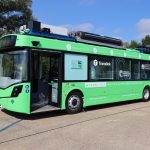Lower total cost of ownership for operators, smoother and quieter journeys for passengers: Zero-emission buses (ZEBs) present characteristics that diesel models struggle to compete with, except perhaps where range is concerned.
Since the first ZEBs were introduced over a decade ago, particularly on battery-electric vehicles (BEVs) limited range has been a major barrier in the minds of operators. Unable to achieve like-for-like service with diesel equivalents, BEVs initially struggled to break through while battery technology and driveline efficiency were in early development.
As we enter a period of mass adoption of ZEBs a decade later, including both battery-electric and hydrogen fuel cell-electric (FCEVs), is the question of range still a major concern?
Analysis of publicly available information by Zemo Partnership’s Bus Working Group found that the average range of a plug-in, depot charged BEV (single- and double-deck) as quoted by manufacturers supplying the UK has increased by 50% from approximately 200km in 2015 to slightly over 300km in the first half of 2022.
Undoubtedly an encouraging trend, these figures come with obvious caveats. In real-world operation, the range of a BEV is dependent on numerous factors including weather conditions, topography, passenger loading and driving style. All could significantly impact the quoted capabilities.
To validate how realistic these figures are, Zemo has also reviewed the theoretical ranges presented on Zero Emission Bus certificates based on vehicle energy efficiency over the UK Bus Cycle, as accredited by Zemo.
Analysis of published certificates on the Zemo website has found that the average range of BEVs (we are yet to test a hydrogen fuel cell-electric bus) is 270km, or 168 miles. Importantly, these ranges account for the effects of passenger loadings and heating over inner-urban, outer-urban and rural phases, providing a representation of real-life operation, and so help to provide confidence that the ranges presented by manufacturers are achievable in service.
300km, or 187.5 miles, of zero-emission range offers operators a solution that can fulfil service on a significant proportion of routes, particularly the so-called ‘low hanging fruit’ in urban areas, as seen with the over 800 plug-in battery-electric buses operating in London.
While 300km of range is significant, it does not provide the same flexibility as a diesel bus for services outside urban centres. Opportunity charging is being considered more often now, as advanced scheduling tools allow operators to reduce battery sizes if there are times of the day when vehicles can charge either on route or in the depot.
With comparable refuelling times, FCEVs provide a closer like-for-like replacement for diesel. But what about range? Analysis carried out by Zemo of publicly available records and publications has found that the average range of FCEVs as quoted by manufacturers supplying the UK has increased by over 33%, from just under 300km in 2015 to over 400km in 2021 – a level that could help to ease the range anxiety of bus operators in rural areas, where plug-in BEVs may be unsuitable.
The recent progression of ZEB ranges has enabled operators to roll out these vehicles on more routes, a fact highlighted by over 1,500 in services and a further 2,000 already funded in the UK. With ever-increasing battery energy density, improving driveline component efficiency and the option of BEV opportunity charging alongside FCEVs, the idea of zero-emission bus range anxiety may soon start to diminish.

























